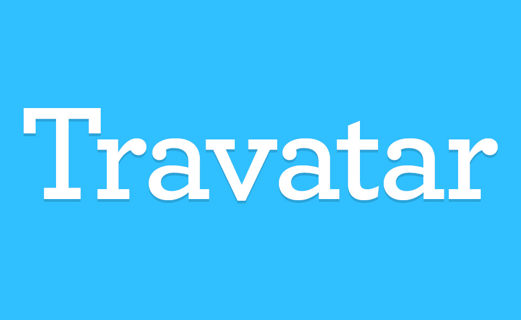This is a post by travel entrepreneur Drew Meyers.

Most of you likely know what Gravatar is (& have an account):
Your Gravatar is an image that follows you from site to site appearing beside your name when you do things like comment or post on a blog.
It’s a drop-dead simple service. All it does is match an email address to a profile photo via a simple API call, yet it’s integrated all over the web on thousands of websites. Why? Everyone on the internet has a profile photo, and millions of sites want to use your profile photo as part of your profile. But, of course, individuals do not want to upload their same profile photo to every site they use. Gravatar lets you upload your photo once, and allow any website to access & use it.
The travel business idea for the taking?
Gravatar, for the travel industry.
Travatar.
Your Travatar is your location that follows you from site to site appearing beside your name when you do things like comment or post on a blog.
Every single traveler is constantly changing location, though they certainly don’t want to update that location on each and every website and app they utilize. On the flip side, every travel startup desires travelers current location to deliver them a relevant, personalized experience.
[Matt Zito and I discussed this concept about 6 months ago, and full credit for the “Travatar” name goes to Matt]
How exactly would this work, and what is needed to bring such a concept to reality?
How it Works
Essentially, it would work just like Gravatar. A simple API that matches on email in the background. So, if site X has a user’s email address — then they can make an API call to fetch their location automatically without making the user grant permissions from Facebook (the current source most sites pull location from).
What’s Needed
Ability to create an account, and log your current location against an email address, and some way to change that location.
The API would be fairly straightforward:
- Input: email address
- Output: flag + text of city, state, country
Profile components:
- name, photo, short bio, website
- fb/twitter links (if authenticated)
- current location
- email address (support multiple like you can on gravatar)
Once the core service is live, then connected services would be the next step to make changing your location as seamless as possible regardless of which services you already use. The no brainer inputs:
- Facebook Checkins
- Foursquare
- Tripit
Down the line, it would likely need a way for travel startups and even the big boys like TripAdvisor and Gogobot to log your current location against your travel profile.
Once it becomes easy and convenient to update your location, then the focus would shift to enabling developers on every platform to easily integrate Travatar into their offerings, via:
- WP native comments – via a WordPress plugin
- Gravatar – (see THIS)
- Disqus
- Livefyre
- Rails gem
Gravatar has already built these integrations, which are available to iterate upon. I’m no developer to know for certain, but my gut is they could all be easily tweaked to work with “Travatar”. I’m sure there are ways to use services like IFTTT and Zapier to make this easier as well.
Why It Makes Sense
The magic of Travatar is enabling more in person relationships to form as a result of bringing transparency to locations of those using the same web services (or reading the same blogs). Like gravater, it would be an extremely light weight — yet flexible – technical solution. I would love for this to exist, as it would help identify where people are who comment on the same blogs I do. Plus, it would allow any website to automatically know where I am without me doing a search for my present location, or entering it in settings.
 Imagine this blog comment scenario. You read a blog post, see 6-7 comments — and realize two of those commenters actually live in the same metropolitan area as you do, giving you the means to reach out to them and grab coffee or drinks to continue the discussion face to face.
Imagine this blog comment scenario. You read a blog post, see 6-7 comments — and realize two of those commenters actually live in the same metropolitan area as you do, giving you the means to reach out to them and grab coffee or drinks to continue the discussion face to face.
Technically, this would be fairly easy. If Travatar account exists for blog commenter email address — return & display current location (text + small flag). If Travatar account & private location selected — return “Undisclosed”. If no Travatar account exists, then use IP address to get the country the comment was made, and surface that country flag next to the comment.
Every community builder on the planet understands that in person conversations are where communities are built. Not online. Travatar enables that possibility to occur more often.
Summary
I’ve spoken to multiple people in the travel industry about the Travatar concept. They all agree it would be a useful tool for travelers, and that developers would like to use (if it had users). Oh Hey World’s code base contains about 85% of what’s needed, and available for anyone to iterate upon.
- Already built API: http://www.ohheyworld.com/api/users/drewmeyers/badge
The question is whether it makes any business sense to build it. Is there a viable business model, or is the only potential outcome a sale?
Is there another Tom Preston-Werner out there (founder of Gravatar prior to GitHub), who cares about this enough to build it and maintain it without a business model – and hope it reaches a scale for TripAdvisor or Expedia or Lonely Planet (or Automattic) to purchase? Tom wrote a post looking back on selling Gravatar to Automattic, that is well worth reading for anyone thinking about this opportunity. Or maybe a development firm that would want to put the finishing touches on it for the branding and mind share of building and maintaining a tool that reaches hundreds of thousands of travelers, and thousands of developers?
What do you think? Is it worth taking this to market?
Drew Meyers is the co-founder of Horizon. Global nomad originating in Seattle. Ex-Zillow community builder. Social Entrepreneur. Microfinance advocate. Travel addict. Find him on Twitter @drewmeyers.
